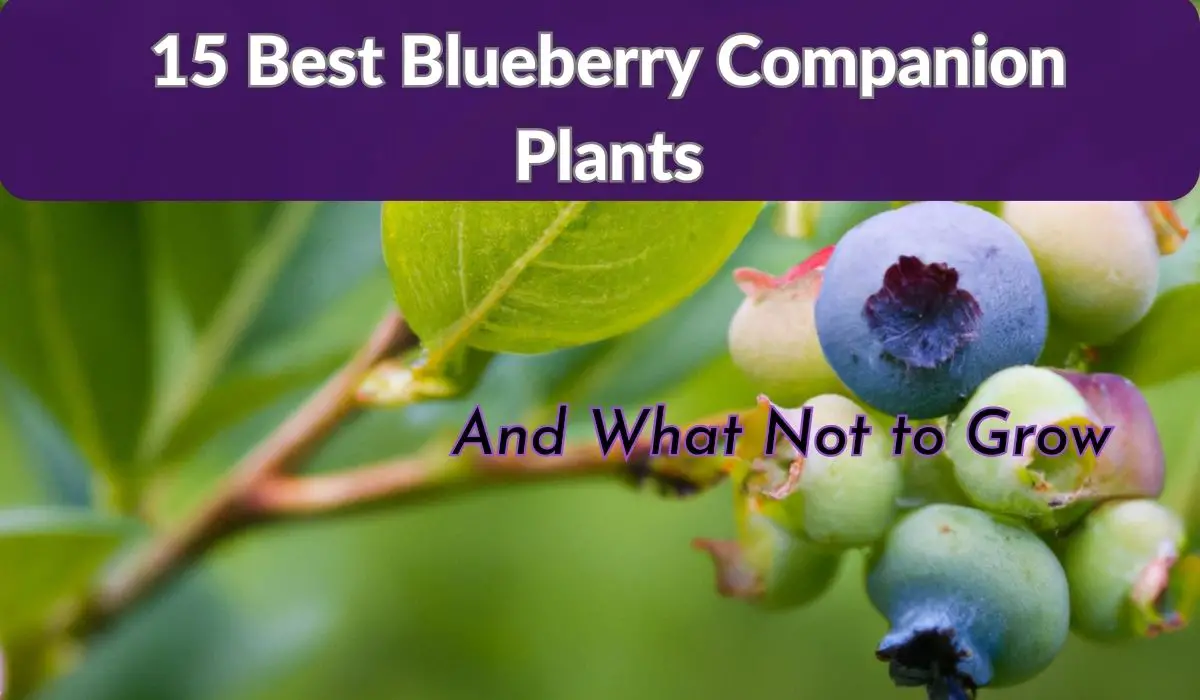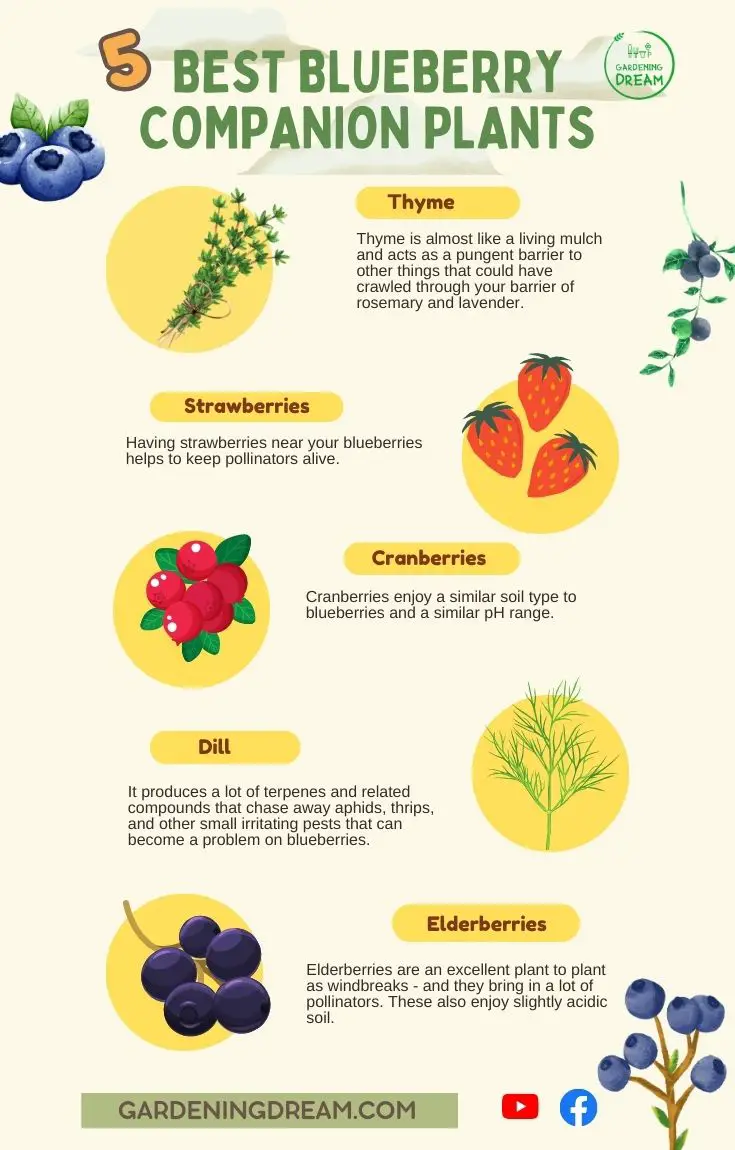Last Updated on May 12, 2023 by Griselda M.
Blueberry companion plants are pretty diverse, and help you to keep your blueberries free of pests and diseases. In recent years, the global blueberry industry has exploded in size, and I have had the good fortune of working with one of the world leaders in this field. This article will share some of the tricks learned through this association.
A Quick Overview of Blueberry Plants
When considering what to use as good blueberry companion plants, it is first important to have an understanding of the basics of a blueberry plant. Many species of plants are called blueberries. There are two main growth types – highbush and lowbush blueberries. Lowbush blueberries are wild blueberries and tend to just be allowed to do their own thing with a little help in nature. For this article, we will be dealing with commercially available and cultivated highbush blueberries.
Highbush blueberries form the cornerstone of a huge international industry, where different regions of the world produce fresh blueberries at different times of the year. These are air freighted around the world to give people “fresh” blueberries nearly year-round. Once you however grow your own, you will find that the “fresh” blueberries in the shop are just not as good.
All plants that are grown in large plantings tend to have continuous improvement in genetics being performed by plant breeders. The result is many cultivars to choose from – I have experience with O’Neal, Duke, and Farthing cultivars. Personally, O’Neal appeals to me – it bears well, and starts quite early, giving a decent harvest season, and the berries are by far my favorite in terms of taste. They start early and produce right into the middle of summer.
Flowers to Grow Near Blueberries
In terms of blueberry companion plants, choosing the right flowers to grow near – as in within 20 to 30 feet – the blueberries really helps to start your season strong. Commercially available highbush blueberry cultivars have been bred to be pollinated by honeybees. For wild blueberries, bumble bees are more appropriate. However, that said, bumble bees and other wild bees are still far better pollinators of blueberries, and planting flowers that attract and sustain small populations of these bees really helps.
When planting flowers to attract natural pollinators of blueberries, it helps to first have a nesting site for these bees. You can read an article I wrote about leafcutter bees and how to allow them to grow sustainably in your garden here. These are important pollinators of blueberries. To learn about the difference between bumble bees (the best pollinator for blueberries) and honeybees (a sort of OK pollinator for blueberries) read this article I wrote.
In order to decide what flowers to grow, and to achieve the best pollination of our blueberries, we need to ask what flowers work well for wild bees (not honeybees) as we want to keep a population of these bees in our area to pollinate our blueberries. Honeybees can fly long distances (a few miles), and if something tasty is keeping them busy they will ignore your blueberry flowers. Wild bees can only forage over a range of a few hundred feet around their nest, so they will tend to focus on the flowers in your garden. The more flowers, the more pollinators.
Bird Netting for Garden (13ft x 33ft)
The best flowers for solitary bees, in my opinion, are perennial basil, rosemary, wisteria (this really helps in spring), fava beans, and peas (bring in bumble bees). One of my favorite early crops to plant for bees is buckwheat. Normally you can buy some seeds at a health food shop – look for seeds with the husks still on. Buckwheat for eating is normally fine if it has husks.
Buckwheat planted in early spring will flower in a few weeks after planting. If you plant it quite densely it smothers out weeds and you can then dig it back into the ground shortly after flowering as a green manure. If you let it go to seed, you will now have buckwheat as a weed! Even a small patch 10 feet long by a few feet wide will sustain a small colony of 20-30 bumble bees. Buckwheat produces a lot of nectar and really helps pollinators get going. It stops producing nectar before midday causing your pollinators to look elsewhere – and find your blueberries.
Companion Plants for Blueberries – The Most Popular
A very useful trick with choosing blueberry companion plants is to plant a hedge of rosemary and a hedge of lavender in a ring right around your blueberry patch. This acts as a barrier to many pests that could enter your blueberry patch and also acts as an attractant for pollinators useful for your plants.
Thyme
You can extend this pest barrier effect by allowing Thyme to grow under the blueberries. Thyme is almost like a living mulch and acts as a pungent barrier to other things that could have crawled through your barrier of rosemary and lavender. I have seen large commercial blueberry farms with thyme growing under the mature blueberry bushes. If mulch the thyme lightly with pine straw, it will often push through.
Strawberries
Blueberries have an ideal soil pH range of 4-5 or so, and strawberries can grow at 5. I have once or twice grown strawberries under my blueberries but generally, they seem to compete a bit. Having strawberries near your blueberries, however, helps to keep pollinators alive.
Cranberries
Cranberries enjoy a similar soil type to blueberries and a similar pH range. I have read of people who have successfully grown cranberries under blueberries – for me this did not work – this may be due to my irrigation water having a pH of around 7.5 due to the nature of runoff I receive into my reservoir and possibly due to the plants in the dam that raise the pH. I have read that rainwater is better for the irrigation of cranberries.
Dill
One of the more interesting blueberry companion plants is a dill plant or two planted in the less acidic soil near your blueberries. Dill is one of those things that becomes a bit of a pest, as it somehow always flowers and sets seeds. I grow it for the seed and use the seeds in my pickling spice. When dill flowers, it attracts a wide range of pollinators. This plant is a pollinator magnet. It also stinks and produces a lot of terpenes and related compounds that chase away aphids, thrips, and other small irritating pests that can become a problem on blueberries.
Wildflowers
In nature, you will often find blueberries in bog-type settings, and around that, on higher ground, you will find meadows with a range of wildflowers. I am a huge believer in recreating meadows in our world – if you have an ugly lawn somewhere that is just wasting your time and money, rewild it into a bee meadow – your garden will thrive because of it.
Elderberries
Elderberries are an excellent plant to plant as windbreaks – and they bring in a lot of pollinators. These also enjoy slightly acidic soil. In my climate, they grow like a weed but only set fruit every few years. When they do, I love making elderberry mead – it has a rich dark purple color and lovely taste. Planting a row of these to break the predominant wind direction that blows over your blueberry patch in spring will allow the patch to warm a bit. This slightly warmer air, with reduced air movement, allows early bees to get into the plants and start pollinating.
The earlier you pollinate flowers, the longer your harvest will be. Creating microclimates with hedgerows is very important to engineering your garden to be more productive.
Blueberries grow well in acidic soil – and not much else that is useful does. In this regard, reserve highly acidic soil for Blueberries, moderately acidic soil for cranberries, and slightly acidic soil for strawberries. As you get to the edge of the acidic patch (I find, unless you live in a bog, that acidic soil is a patchy luxury).
Blueberry Companion Plants Permaculture Tips
In choosing blueberry companion plants for permaculture, we try to grow them with minimal pesticide or chemical interventions. Hence, all of the above tips become more important. The hedge of herbs, the understory of thyme, and the dill are significant for keeping pests away, minimizing our use of chemicals (even neem), and ensuring nutrient cycling into the soil. The same logic of planting as per the normal companion planting listed above, applies to permaculture.
What Not to Grow Near Blueberries
Generally, plants such as tomatoes, potatoes, eggplant, and to a lesser extent peppers/chilis tend to attract pests that can also be a problem on blueberries. I have a problem with cherry tomatoes that can become a weed in my garden. If you do not keep a careful eye on these delightful problem plants they can run all over your garden and will try to climb the blueberry plant. Trying to untangle these causes damage to the blueberry.
Tomato plants are also a magnet/breeding zone for spider mites, and in the mid-summer heat, these can migrate to the blueberries where they cause significant damage from which the plants will sometimes not recover.
The cabbage/cauliflower/kale/brussel sprout/broccoli cluster of plants is a disease magnet for aphids and white flies especially. These drift over to become a problem for blueberries. This group of plants requires quite alkaline soil compared to blueberries that enjoy a very acidic soil, hence there is little logic in planting them near each other anyhow.
Squash also appears to be a bad combination as they can grow a few feet a day, and if you go away for three days, you come back to find your blueberries buried under a heap of squash. Squash is, like cherry tomatoes, prone to take over your garden.
Quick Summary – Companion Plants for Blueberries
So you can look at:
1. Perennial basil (keep it indoors in winter)
2. Rosemary
3. Wisteria
4. Fava beans
5. Peas
6. Buckwheat
7. Thyme
8. Strawberries
9. Cranberries
10. Dill
11. Wildflowers (normally 5-10 species in the mix)
12. Elderberries
13. Lilacs
14. Azaleas
15. Basil
The best companion plants for blueberries are those that flower, chase pests away, and attract pollinators. You can also consider plants such as lavender, buckwheat, fava beans, peas, dill, sweet alyssum, and cornflower that for instance can be planted to keep populations of bumble bees and wild bees healthy. You can also plant blueberries near flowers like lilacs and azaleas.
Some suggest planting lush rhododendrons and azaleas as companion plants for blueberry – I would however caution against rhododendrons as increasingly large amounts of research suggest that these plants produce nectar that is toxic to many species of bees. Blueberries need pollinators – the last thing you want to do is to kill those.
Dr. Garth A. Cambray is a Canadian/South African entrepreneur and beekeeper with 28 years of experience in apiculture and specializes in adding value to honey. His Ph.D. research developed a new advanced continuous fermentation method for making mead that has resulted in a number of companies globally being able to access markets for mead. His company, Makana Meadery, exports honey mead to the USA where it is available to discerning connoisseurs. He has also developed technologies to commercially manufacture organic honey vinegar in Zambia for export globally. He holds a few patents globally in the ethanol industry and believes in technology and knowledge transfer for human development and environmental sustainability. One of his proudest achievements is the fact that the wind farm he started at one of his old apiary sites has essentially made his hometown carbon neutral.




